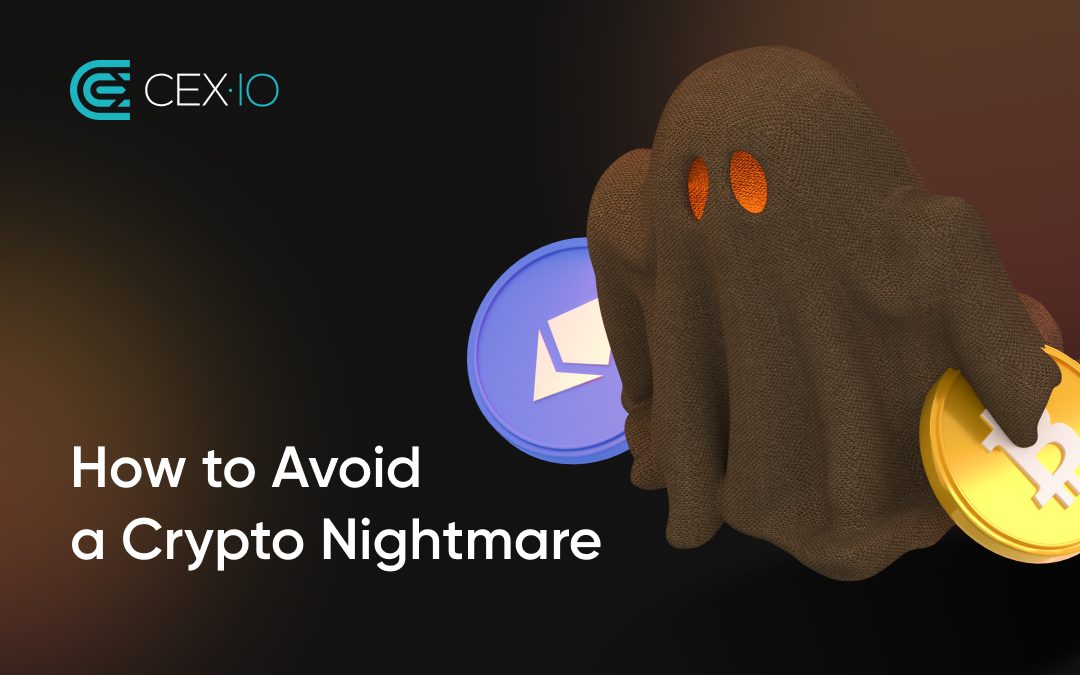October may be over, but Halloween is a unique and memorable holiday.
In true CEX.IO spirit, we organized a creativity contest on Twitter granting USDT tokens to five lucky winners who submitted fun and creative stories of their scariest crypto nightmares.
Our winners were indeed creative, but also raised legitimate crypto-related concerns. Therefore, in addition to celebrating their creativity, we also wanted to put their minds at ease and show how you can deal with/avoid each of these crypto fears and issues.
Below are the winners’ stories, and our team’s expert tips on how to deal with them.
1. Crypto fraudsters
How to avoid this issue
Cryptocurrencies are popular globally and potentially lucrative. As such, they can represent fertile soil for nefarious and fraudulent market actors. It is critical to remember that performing ample research and due diligence is the best way to protect yourself from being scammed.
Additionally, do your best not to take crypto advice from internet forums, individuals on social media, celebrities, or anyone else you don’t know well.
In fact, one of the most common ways crypto enthusiasts fall victim to these scams is by responding to offers that promise to “double your investments with one click.” Such scams often involve sending crypto to unknown groups or individuals, which more often than not results in users losing their hard earned crypto.
Instead, your safest bet is to focus on established and renowned individuals and companies with solid financial credentials (like CEX.IO).
2. Forgetting wallet passwords
How to avoid this issue
Most crypto wallets nowadays feature automatic logins, like FaceID or Thumbprint ID (depending on your type of smartphone). If you’re using a laptop/tablet/desktop computer, you likely also have a code. Alternatively, you could also consider using trusted custodial wallets, not to mention that, with CEX.IO, you can always restore your passwords.
3. Lost crypto opportunities
How to avoid this issue
The cryptocurrency market is unpredictable and volatile. In other words, there is no guaranteed way to recognize when an asset’s price will go up or down.
However, we monitor the markets 24/7 to observe and analyze trends in an attempt to understand market behavior.
To that end, portfolio diversification could be a wise choice for risk management. Also, staking is another option available on our platform that has the potential to minimize the effects of market volatility. You can learn more about it here.
Also, if you’re interested in learning more about perspective tokens, check out CEX.IO University, or bookmark our blog for regular crypto spotlight pieces.
4. Hacking
How to avoid this issue
Hacking is a scary thing to experience in this day and age of the internet, and even more so when it comes to crypto. However, there are numerous ways you can protect your crypto wallet from being hacked.
Examples include storing your crypto in a “cold” wallet, regularly changing your password, using 2-factor authentication, and avoiding public WiFi when accessing your crypto assets. For maximum safety, we recommend combining two or more of these methods to ensure your crypto portfolio is thoroughly protected.
5. Market crash
How to avoid this issue
As mentioned above, financial markets — crypto included — are unpredictable. They also move in a cyclical fashion, meaning crashes occur periodically. Regardless, not all is lost (pun intended) even when the markets go down, because there are ways to minimize your losses.
(as the old saying goes – “a loss isn’t a loss until you sell”).
For example, the oldest rule in the investing book is to only invest funds you can afford to lose. Simultaneously, consider having an emergency fund to cushion the blow of a market downturn. While you’re at it, choosing to diversify your investment portfolio can help avoid the second oldest rule of “not putting all your eggs in the same basket.”
Lastly, you may even consider choosing only cryptocurrencies with long-term potential (such as the oldest/biggest names in the game) or that offer a tangible solution beyond speculative value.
This is by no means an exhaustive list of all the risks that exist in the cryptocurrency space. Nevertheless, we hope that by sharing these experiences, and the hard-earned wisdom they can impart, you’re better equipped to make the most informed decisions along your crypto journey.
Disclaimer: Information provided by CEX.IO is not intended to be, nor should it be construed as financial, tax or legal advice. The risk of loss in trading or holding digital assets can be substantial. You should carefully consider whether interacting with, holding, or trading digital assets is suitable for you in light of the risk involved and your financial condition. You should take into consideration your level of experience and seek independent advice if necessary regarding your specific circumstances. CEX.IO is not engaged in the offer, sale, or trading of securities. Please refer to the Terms of Use for more details
